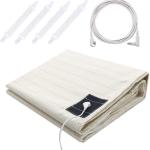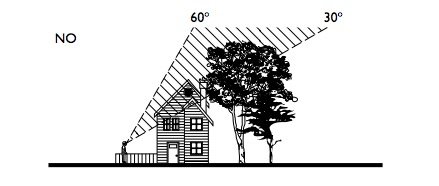Here are some tips for pointing a satellite dish to improve the signal strength:
- Make sure the dish is positioned in a clear line of sight to the sky. Obstacles such as trees, buildings, and mountains can block the signal, so it’s important to position the dish in an open area with as few obstructions as possible.
- Use a satellite dish pointing calculator to determine the precise direction in which you need to aim the dish. These calculators can be found online and use your location and the satellite you want to receive a signal from to provide the necessary aiming information.
- Use a compass or smartphone app to help you find the correct direction. Once you have the aiming information from the calculator, use a compass or smartphone app to help you locate the correct direction.
- Adjust the elevation angle of the dish. The elevation angle refers to the angle of the dish relative to the ground. Make sure the dish is positioned at the correct elevation angle as indicated by the calculator.
- Fine-tune the dish position. Once the dish is roughly aimed in the correct direction, fine-tune the position by adjusting the dish slightly and checking the signal strength on your receiver.
- Check the polarisation angle. The polarisation angle refers to the orientation of the dish’s feedhorn, which is the part of the dish that receives the signal. Make sure the polarisation angle is set correctly as indicated by the calculator.
By following these tips, you should be able to improve the signal strength of your satellite dish.
Pointing a satellite dish:
Make sure the dish is positioned in a clear line of sight to the sky. Obstacles such as trees, buildings, and mountains can block the signal, so it’s important to position the dish in an open area with as few obstructions as possible.
Use a satellite dish pointing calculator to determine the precise direction in which you need to aim the dish. These calculators can be found online and use your location and the satellite you want to receive a signal from to provide the necessary aiming information.
Use a compass or smartphone app to help you find the correct direction. Once you have the aiming information from the calculator, use a compass or smartphone app to help you locate the correct direction.
Adjust the elevation angle of the dish. The elevation angle refers to the angle of the dish relative to the ground. Make sure the dish is positioned at the correct elevation angle as indicated by the calculator.
Fine-tune the dish position. Once the dish is roughly aimed in the correct direction, fine-tune the position by adjusting the dish slightly and checking the signal strength on your receiver.
Check the polarisation angle. The polarisation angle refers to the orientation of the dish’s feedhorn, which is the part of the dish that receives the signal. Make sure the polarisation angle is set correctly as indicated by the calculator.
By following these tips, you should be able to improve the signal strength of your satellite dish.
General Site Survey to Get a Good Satellite Signal:
The satellite dish must be pointed directly at the satellite, with NO obstructions between the two. This means NO trees and NO buildings. Take into consideration future tree growth, house remodeling or additions and new construction in your area. The satellite signal WILL NOT PASS through leaves or branches.
Use a Satellite Look Angle calculator website to determine the proper Dish Pointing angles.
Finding a Clear Line of Sight:
Get yourself a good compass, the best you can afford. Check the “Azimuth” and “Elevation” for your location here! Locate at least one site on your property that has a clear view to the satellite. Do you have at least one clear view to the satellite? Remember, no trees, leaves, or buildings can be between the dish and the satellite. If the answer is NO, your site may not be suitable for installing the satellite system.
If the answer is MAYBE, you may want to contact a local digital satellite dealer for information about having a professional installer conduct a thorough site survey. If the answer is YES, your site should be suitable for installing the system. Go ahead to the next section of these instructions.
Where Is Galaxy 19 (97W) Satellite?
This satellite direction is always south of Texas. That means if you live in Florida, you must have a clear line of sight to the southwest; if you live in California, you must have a clear line to the southeast. Depending on where you live, the satellite will be at an elevation angle between 30 and 60 degrees. Southern states point more toward 60 degrees; northern states point more toward 30 degrees. Use the Satellite Look Angle calculator to determine your Dish Pointing elevation and azimuth.
LNBF Polarization Tilt (skew):
Your LNB is marked with a label indicating the polarization tilt. Your local LNB polarity offset information varies by location. If you are in Houston, TX your LNB polarization is to be set at 0 degrees. But if you are on the California coast your LNB polarization could be as much as minus 30 degrees (clockwise rotation). And if you are in Maine your LNB polarization could be as much as plus 30 degree (counter-clockwise rotation.
Peaking the Dish Pointing angle and adjusting the polarity of the LNB will greatly improve your Satellite Signal Quality reading. When adjusting your LNBF, be sure you don’t leave that LNBF holding bracket loose.
The LNBF won’t pick up the satellite if the bracket is loose, and it’s slightly off. Finally, when thinking about degrees, remember that 30 degrees is about 5 minutes on a clock. Don’t turn the LNB too much! Make certain that the pole or tri-mast assembly is vertically plumb.
Check it with an Angle Finder or a level. If the pole or tri-mast is not plumb, your azimuth and elevation will not be accurate and will cause difficulty when Dish Pointing. Also, if you are using a pole mount, make certain you pour a sufficient footing that will provide proper ballast. A pole that does not have sufficient ballast will lean over time, causing you to lose the Satellite Signal.
Your mount must be very strong and can not wobble. You must use at least 4 lag screws (correct size for your installation) in the base mount one on each corner. When pointing the satellite dish, allow 5-10 seconds between any movements of the dish.
This allows the receiver to complete a Satellite Signal scan, and lock indicating that you have located the signal. A reasonable Satellite Signal strength is between 50 and 80. If it is lower than that range, you are either pointing into an object (e.g. trees, shrubs, or structures) or pointing above or below the satellite.
Your satellite dish installation position must have a clear view angle of the satellite you are trying to receive. There are other satellites within 2 degrees to the left or right that may use the same frequency. This will provide a strong Satellite Signal strength reading but no signal quality or signal lock. If you have a high strength reading but are not able to lock on, try adjusting the dish slightly to the right or left.
When you are attempting to set up a satellite dish in a heavily wooded area or one with lots of man made obstructions, it helps to understand how the Dish Pointing really works. One common misconception is that the dish points ‘directly’ at the satellite. This isn’t the case for most dish designs.
The apparent elevation of the dish is 15 or more degrees lower than it’s actual receiving window. Have a look at this diagram…. it’s easier to see it than it is to explain it….. If you complete the above steps properly, your chance of a successful installation is 99.9%. and you are trying to aim your dish that the receiver waits about 3-5 seconds after it locks on to the correct Satellite Signal before it registers on the receiver’s signal meter on the antenna aiming screen on your TV.
Move your dish in very small increments (2 deg East or West each instance until you find the signal then 1 deg to peak signal). If you move the Dish Pointing too fast and do not pause between moves you might go thru the signal before the receiver can tell you that you are on the signal.
If you use a signal meter you can hook it into the system right at the dish and it responds to the Satellite Signal immediately making it much easier Dish Pointing. You do not need any one else to help you if you use a meter at the dish.
Compare Satellite Signal Strength and Quality Zero Strength and Zero Quality:
If this is the symptom you are experiencing, then the receiver is currently not receiving the Satellite Signal from the dish. Check all connections between your receiver and satellite dish. Make sure that they are all plugged in to the proper place and are tight.
One of the most common connection problems is to have the cable coming from the dish plugged in to the connection marked “In from Antenna,” which is incorrect. The cable coming from the dish needs to be plugged in to the connection marked “In from Dish, Digital In, or LNB IN”One of the most common connection problems is to have the cable coming from the dish plugged in to the connection marked “In from Antenna,” which is incorrect.
The cable coming from the dish needs to be plugged in to the connection marked “In from Dish, Digital In, or LNB IN”
Also, the cables might have developed a short or might have gotten moisture in them, especially out at the dish. If this is a possibility, you may want to have an installer check the cables or take them to an installer yourself.
Satellite Signal Strengths Meter:
0-30 Strength and Zero Quality:
If you are experiencing these levels of strength and quality, you are getting only noise signals. Make sure that there are no obstacles between the dish and satellite.
40-60 Strength and Zero Quality:
With this level of strength and a lack of quality, it is very likely that the dish has moved since its initial installation or you are still off alignment. We recommend going through the Dish Installation pointing steps and finding the satellite signal again. This will likely take just a few minor adjustments of the dish since it should not have moved very much. Key causes for this problem include bolts not being tightened properly, heavy winds, or the dish being struck or bumped by something. Once the Satellite Signal has been found again, make certain all bolts are tightened well.
We also recommend that once you have everything tightened down and have your signal back, make a mark from the cap mount to the pole with paint or some other permanent substance. This will give you a reference point, should any future problems occur. You can also make a mark on the side of the cap mount where your elevation markings are imprinted.
40-60 Strength and 30-70 Quality:
This level of strength and quality indicates that the dish needs to be fine-tuned to the satellite. You may have noticed that prior to getting the “Bad or No Signal” message your picture was occasionally blotchy and your audio may have been out of sync with the picture. These are all symptoms of the need to fine-tune the dish. Optimum signal quality is between 70 and 100.
Satellite Signal Meter TIP:
You can fine-tune your dish by going back to the Satellite Signal strength screen. While the signal bar is running, have someone out at the dish. He will need to loosen the collar that holds the LNB. This is done by slightly loosening the two screws that hold the collar together. Once these screws are loose, slowly twist the LNB a fraction of an inch. After each movement allow 5 seconds for the receiver to register the change and update your quality reading.
If the quality readings immediately begin to get lower while the adjustments are being made, then the LNB needs to be turned in the other direction. Once the LNB fine tuning is complete, tighten the two screws on the LNB collar. You may then complete the scan by pressing START.
General Informational and Instructional Links:
- What satellite TV system I can use to view the free to air FTA channels?
- All FTA Ku-band channels in English available in USA
- Free To Air Satellite TV Channels List
- Worldwide Free-To-Air Satellite Channels
- Satellites List North South America Atlantic
- Look-up Latitude and Longitude – USA
- Channels FTA Free To Air Satellite TV
- What is the Satellite Antenna Dish size required or recommended?
- Over-the-Air Reception Devices Rule
- Finding a Professional Installer in your area in USA
- General Satellite Dish Antenna Installation Instructions
- Installing a Motorized Satellite System with an HH-Mount Motor, DiSEqC & USALS Compatible Motors






























Testing Image Attributes
Unveiling the Future of Hydration: SPE/ PEM Hydrogen Rich Generator Water Ionizer Bottle
Luxurious Modern Living Room designs | Modern Living Room design ideas 2023 |
Best lighting for YouTube videos #youtube
WORDPRESS WEBSITE PERFORMANCE: How To Optimize Your WordPress & WooCommerce Website
WordPress Speed and Performance Testing: How To Do a Page Loading Speed Test and Monitor Your WordPress & WooCommerce Websites
Startup Resilience: Overcoming Small Business Challenges, Embracing Entrepreneurial Triumph
Eye-catching 2024 Grand Design Imagine AIM Travel Trailer RV For Sale in
🔴SPORT CARS DISTRO BREATBEAT TOP 12
1,000 New Black Hornet Drones to Ukraine
How This Aquaponics Farmer Is Reinventing Urban Agriculture
INCREDIBLE INVENTIONS FOR THE ROOF OF YOUR HOUSE
The Ultimate Blackout Survival Guide
Best Solar Generator for 2023 (The Ultimate Guide)
Acura of Stamford Auto Care Service Center | Fairfield Darien Norwalk Danbury